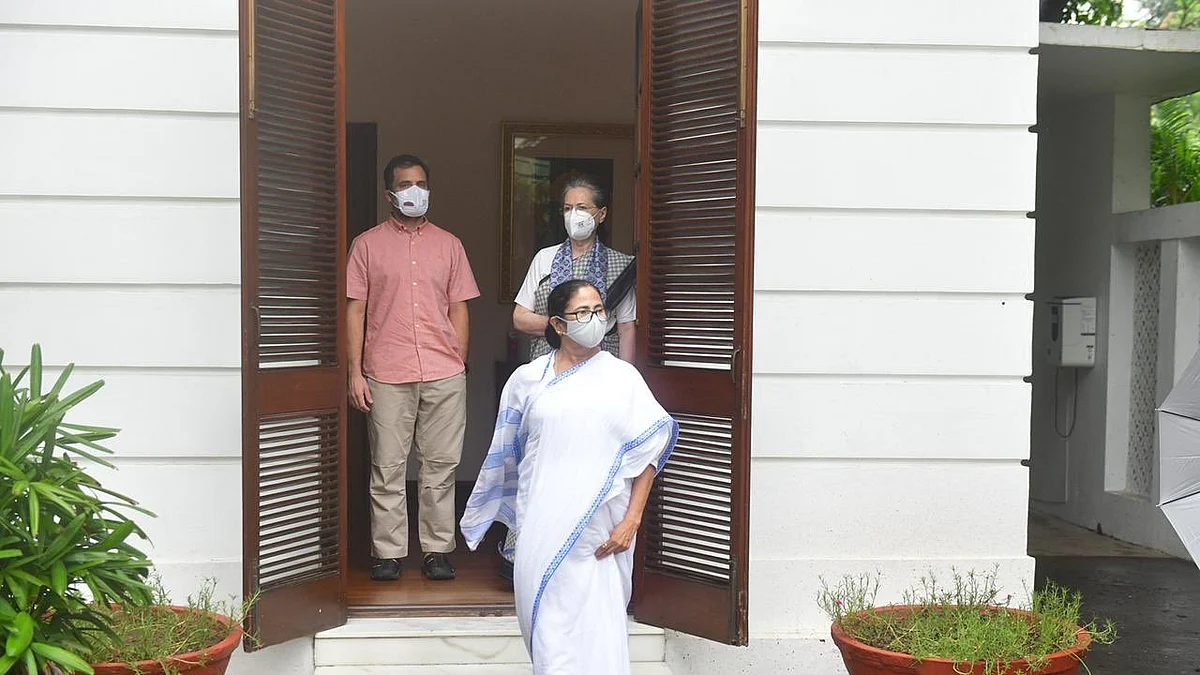Led by Congress, a united Opposition is all set to mount a formidable challenge to BJP and oust it from power
With more than two and a half year to go for next general elections, Opposition has enough time to form a strategy to oust the BJP from the Centre, where it is already under fire on several issues

She came, she saw but did West Bengal Chief Minister Mamata Banerjee conquer Delhi? The jury is still out on that.
But if the developments during the past one week are any indication, the endeavor to forge a united opposition front to take on the BJP seems to have succeeded to a large extent.
During her four day stay in Delhi, Banerjee met Congress president Sonia Gandhi and prominent Congress leaders like Rahul Gandhi, former MP CM Kamal Nath and Rajya Sabha members Anand Sharma and Abhishek Manu Singhvi.
She also paid courtesy visits to Prime Minister Narendra Modi and Union Roads and Highways Minister Nitin Gadkari.
She also met Delhi CM Arvind Kejriwal and DMK’s Rajya Sabha member Kanimozhi.
Mamata is evidently well aware that no Opposition unity is possible without the Congress, with its stature as a national party.
Most of other non-Congress Opposition leaders’ influence is confined to their own states. They head regional parties like Samajwadi Party, Rashtriya Janata Dal, YSR Congress, Telengana Rashtra Samiti, Shiv Sena, Nationalist Congtess Party, Biju Janata Dal etc
AAP had contested Lok Sabha elections in 432 constituencies in almost all the states in 2014, but could win only four, in Punjab. It drew a blank in Delhi, where it was founded. In the 2019 next elections, it contested 40 seats across nine states and Union Territories, and won only one seat, again in Punjab. Its vote share In Delhi plummeted from 33 per cent in 2014 to 18 per cent in 2019.
Congress thus, is the only party having a significant political significance in at least 15-16 states. In some states like MP, Chhattisgarh, Rajasthan, Gujarat, Karnataka, Himachal Pradesh and Uttarakhand, it is locked in a direct contest with the BJP.
Mamata also let it be known loud and clear that she wasn’t eyeing the Prime Ministerial position. To a media query, she said, “I have a house in Kolkata and I am happy to live there. I have no plans and desire to come and live in Delhi”.
The Congress received her with open arms but subtly also laid its claim on the leadership position in a opposition front. Rahul Gandhi attended the 14-party meeting to chalk out a joint strategy to pin the government on the Pegasus Snoopgate issue, and lead the meeting from the front.
Next day, when Mamata called on Congress president Sonia Gandhi at her residence, Rahul Gandhi was very much in attendance – another subtle indication that no opposition unity talks are possible without him and that the latter is the candidate to lead the opposition front.
In fact, ever since the Corona pandemic broke out last year, Rahul Gandhi has been taking on the Modi govt on various issues – whether it was the sudden country-wide lockdown making lakhs of workers trudge thousands of kms on their way home; or the reopening of country; or universal vaccination policy and allowing foreign vaccines in India.
Congress might have bagged 52 seats in the 2019 general elections, but it went on to win state assembly elections in Punjab, Rajasthan, Madhya Pradesh and Chhattisgarh, and was sharing power in Karnataka, Maharashtra and Jharkhand. The party lost states like Haryana, Gujarat, Goa, Arunachal Pradesh and Manipur with a very narrow margin.
Congress is now gearing up for Assembly elections to seven states next year – UP, Uttrakhand, Punjab, Goa, Manipur in February/March and Gujarat and Himachal Pradesh in October/November 2022.
History of Opposition unity
The Opposition unity efforts in 1977, 1989 and 1996 brought them to power at the Centre but only with support of the Congress, which supported a spectrum of opposition parties from the outside. All the three experiments proved fragile because of their inherent contradictions and after their fall, Congress came to power in the first two instances while BJP formed the government in 1998 with support of an array of parties.
In all three instances, the only glue for Opposition unity was to throw out the Congress from power. Yet, the alternatives had to lean on Congress support in all three instances – whether it was Charan Singh’s govt or those led by Chandra Shekhar or Deve Gowda and then IK Gujral (both sustained by outside support of the Congress).
The UPA governments from 2004 to 2014 amply demonstrated how a coalition government can be run.
The way forward
With the Congress already on board, Mamata Banerjee would need to bring other allies around. CPM has already clarified that it would continue to fight the BJP in West Bengal and has no qualms in joined hands with Mamata Banerjee to form a joint Opposition front.
Similar understanding needs to come from BJD, TRS and YSR Congress – which together have a stake on 63 seats.
With more than two and a half year to go for next Parliamentary elections, the opposition has enough time to form a strategy to oust the BJP from the Centre, which is already under fire on several issues.
Mamata Banerjee’s aggressive campaign, resulting in a resounding victory of the TMC over the BJP in the recently-concluded West Bengal Assembly elections, has bolstered not only her morale but of the entire Opposition. They now just need to translate this enthusiasm into concrete efforts.
Follow us on: Facebook, Twitter, Google News, Instagram
Join our official telegram channel (@nationalherald) and stay updated with the latest headlines
